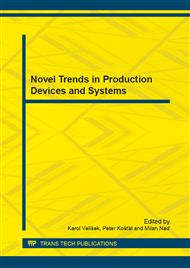p.35
p.42
p.49
p.55
p.61
p.67
p.73
p.79
p.85
CA Systems and Modularity Principles as Tools for Flexible and Efficient Production Systems Design
Abstract:
The article discusses the CA systems use and the application of the modularity principles in the design new, or modernizing existing production systems. This paper describes the principle of modularity as a tool for streamlining design. Design of system with the help of computers and assisted by programs. These allow creating 3D model design before the actual implementation. It is also possible to compile a control circuit simulation and detect and eliminate deficiencies still in design stage. In paper conclusion is illustrated design, automation of existing painting line for the varnish handles. Described principles have been applied, as well as CA systems, CATIA and FluidSim.
Info:
Periodical:
Pages:
61-66
Citation:
Online since:
January 2014
Authors:
Keywords:
Price:
Сopyright:
© 2014 Trans Tech Publications Ltd. All Rights Reserved
Share:
Citation:


